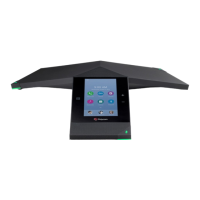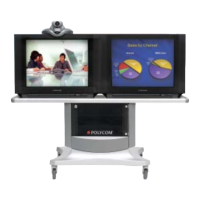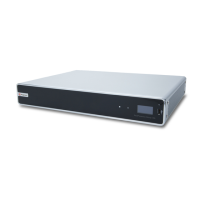Do you have a question about the Polycom HDX 8000 series and is the answer not in the manual?
Guides on physically placing HDX systems and their components for optimal performance and viewing.
Instructions for correctly powering HDX systems on and off, including self-test procedures.
Steps for initial system setup, including the setup wizard and admin settings.
Settings for configuring IP addresses, subnet masks, and default gateways for network connectivity.
Configuration options for using the Session Initiation Protocol (SIP) to connect IP calls.
Details on connecting HDX systems to ISDN networks using BRI, PRI, and serial interfaces.
Steps to configure HDX systems to work correctly within firewall or NAT environments.
Guides on connecting various monitors to different Polycom HDX system models.
Information on connecting and configuring various Polycom EagleEye cameras to HDX systems.
Options for adjusting camera aspect ratio, name, source, and overall video quality.
Instructions for connecting microphones and other audio sources to HDX systems.
Guides on connecting speakers or headphones to various Polycom HDX system models.
Configuration for enabling and testing stereo audio output and microphone input.
Steps to connect computers to HDX systems for sharing content during calls.
Settings to configure how content is displayed on monitors during calls.
Feature allowing presenter to appear over shared content, enhancing presentation engagement.
Methods for providing real-time text transcriptions or language translations during video conferences.
Options to manage call duration, display time, and call detail reporting.
Settings to enable and manage participation in multipoint conferences.
Options for managing system names, localized names, and directory entries for easier contact access.
Settings for country, language, time zone, and daylight saving for system localization.
Options to tailor the system's home screen for different user types and environments.
Explains access control mechanisms that protect system configuration and user data.
Enables secure communication protocols like TLS and HTTPS for system access and management.
Covers local and external authentication methods for user and administrator access.
Standard feature to automatically encrypt calls for secure media transport.
Procedures for generating, installing, and managing digital certificates for secure connections.
Overview of accessing and using the web interface for system configuration and management.
Storing and uploading system configurations as profiles for backup and deployment.
Configuration for Simple Network Management Protocol for system monitoring and status reporting.
Customizing how the remote control interacts with the HDX system based on user environment.
Steps for initial setup, connection, and pairing of the Polycom Touch Control device.
Feature enabling detection and pairing of HDX systems with mobile applications for remote control.
Overview of available diagnostic screens for reviewing system status, call, network, video, and audio performance.
Provides detailed information about ongoing and past calls, including speed, protocol, and packet loss.
Diagnostic tools for testing network connectivity, including PING and Trace Route.
Diagnostic tools for testing speaker connections and audio meter levels for microphones and inputs.
Guidance on performing test calls to verify system setup and network connectivity.
Instructions for restoring system configuration or performing a factory restore using the hardware button.
Diagrams illustrating video input and output connectors for various Polycom HDX system models.
Diagrams showing audio input and output connectors for different Polycom HDX system models.
Detailing IP port usage for inbound connections to the HDX system, including protocol and function.
Detailing IP port usage for outbound connections from the HDX system.
Table showing maximum allowable H.323/SIP point-to-point dialing speeds for each system.
Table showing maximum allowable H.323/SIP dialing speeds for multipoint calls based on sites and features.
Details default values and configurability for admin settings under Maximum or High security profiles.
Details default values and configurability for admin settings under the Medium security profile.
Details default values and configurability for admin settings under the Low security profile.
Details default values and configurability for admin settings under the Minimum security profile.
| Microphone | Polycom HDX Microphone Array |
|---|---|
| Network Protocols | H.323, SIP |
| Network Interface | 10/100/1000 Ethernet |
| Network Interfaces | 10/100/1000 Ethernet |
| Video Standards | H.263, H.264 |
| Video Resolution | 720p, 1080p |
| Content Sharing | H.239, People+Content |
| Audio Standards | G.711, G.722, G.728, G.729A |
| Encryption | H.235 (AES) |
| Camera | Polycom EagleEye HD camera |
| Data Standards | H.239 |
| Video Inputs | HDMI, DVI-I |
| Video Outputs | HDMI, DVI-I |
| Audio Inputs | 3.5mm stereo line-in |
| Audio Outputs | RCA |
| Display Outputs | HDMI, DVI-I |












